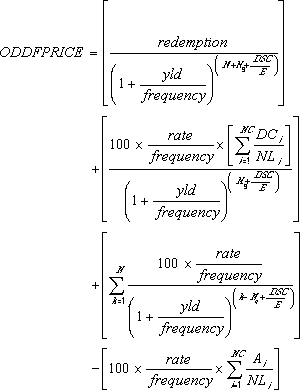IPMT ফাংশন হলো একটি Microsoft Excel ফাংশন যা একটি ঋণের নির্দিষ্ট সময়কালের জন্য আগ্রহের পরিমাণ গণনা করে। এটি নিয়মিত, সমান পরিমাণে কিস্তি এবং একটি Fixed মুনাফা হারের উপর ভিত্তি করে কাজ করে।
IPMT ফাংশন কিভাবে কাজ করে?
IPMT ফাংশন 6 টি আর্গুমেন্ট গ্রহণ করে:
- rate: প্রতি সময়কালের সুদের হার (দশমিক সংখ্যা)
- per: আপনি যে সময়কালের জন্য আগ্রহ খুঁজে পেতে চান (1 থেকে nper পর্যন্ত)
- nper: ঋণের মোট কিস্তির সংখ্যা
- pv: ঋণের বর্তমান মূল্য (এককালীন পরিমাণ যা ভবিষ্যতের কিস্তির সিরিজের মূল্য এখনই)
- fv: ভবিষ্যতের মূল্য (ঐচ্ছিক; কিস্তি শেষ হওয়ার পরে আপনি যে নগদ ভারসাম্য অর্জন করতে চান)
- type: কিস্তি কখন দেওয়া হয় (0 বা 1; ডিফল্ট 0)
IPMT ফাংশন প্রথম সময়কালের জন্য আগ্রহের পরিমাণ গণনা করে এবং তারপরে প্রতিটি পরবর্তী সময়কালের জন্য আগ্রহের পরিমাণ গণনা করতে পূর্ববর্তী সময়কালের শেষ ভারসাম্য ব্যবহার করে।
IPMT ফাংশন ব্যবহারের নিয়ম:
- rate: সুদের হার একটি দশমিক সংখ্যা হতে হবে।
- per: per 1 থেকে nper পর্যন্ত একটি পূর্ণসংখ্যা হতে হবে।
- nper: nper একটি পূর্ণসংখ্যা হতে হবে।
- pv: pv একটি সংখ্যা হতে হবে।
- fv: fv একটি সংখ্যা হতে পারে (ঐচ্ছিক)।
- type: type 0 বা 1 হতে পারে (ঐচ্ছিক; ডিফল্ট 0)।
IPMT ফাংশন ব্যবহারের উদাহরণ:
ধরুন আপনি 8,000 টাকা ঋণ নিয়েছেন যার বার্ষিক সুদের হার 10%। ঋণটি 3 বছরের মধ্যে নিয়মিত, সমান পরিমাণে কিস্তিতে পরিশোধ করা হবে। প্রথম মাসে আগ্রহের পরিমাণ কত হবে তা খুঁজে বের করতে, আপনি নিম্নলিখিত IPMT ফাংশনটি ব্যবহার করতে পারেন:
=IPMT(0.1/12, 1, 36, 8000)এই ফাংশনটি -66.67 ফেরত দেবে। এর মানে হল প্রথম মাসে আগ্রহের পরিমাণ 66.67 টাকা।
IPMT ফাংশন ব্যবহারের গল্প:
একজন ব্যক্তি একটি ব্যাংক থেকে 8,000 টাকা ঋণ নিয়েছেন। ঋণের বার্ষিক সুদের হার 10% এবং ঋণটি 3 বছরের মধ্যে নিয়মিত, সমান পরিমাণে কিস্তিতে পরিশোধ করা হবে। প্রতি মাসে কিস্তির পরিমাণ কত হবে তা জানতে চান ব্যক্তিটি।
ব্যক্তিটি Microsoft Excel ব্যবহার করে IPMT ফাংশনটি ব্যবহার করতে পারেন। প্রথমে, ব্যক্তিটি নিম্নলিখিত ডেটা টেবিলে প্রবেশ করবে:
| ডেটা | বর্ণনা |
|---|---|
| rate: | 0.1 |
| per: | 1 |
| nper: | 36 |
| pv: | 8000 |
| fv: | 0 |
| type: | 0 |
ফর্মুলা:
=PMT(0.1/12, 36, 8000)ফলাফল:
222.22এই ফলাফলটি বলে যে প্রতি মাসে কিস্তির পরিমাণ 222.22 টাকা হবে।
এই তথ্য ব্যবহার করে, ব্যক্তিটি তার ঋণের জন্য একটি বাজেট তৈরি করতে পারেন এবং নিশ্চিত করতে পারেন যে তিনি প্রতি মাসে তার কিস্তিগুলি সময়মতো পরিশোধ করতে পারবেন।
IPMT ফাংশন ব্যবহারের সুবিধা:
- IPMT ফাংশন ব্যবহার করা সহজ এবং সরল।
- এটি আপনাকে একটি ঋণের জন্য প্রতিটি সময়কালের জন্য আগ্রহের পরিমাণ গণনা করতে সহায়তা করে।
- এটি আপনাকে আপনার ঋণের জন্য একটি বাজেট তৈরি করতে সহায়তা করে।
IPMT ফাংশন ব্যবহারের সীমাবদ্ধতা:
- IPMT ফাংশন কেবল নিয়মিত, সমান পরিমাণে কিস্তি সহ ঋণের জন্য কাজ করে।
- এটি সুদের হারের পরিবর্তনের জন্য অ্যাকাউন্ট করে না।
উপসংহার:
IPMT ফাংশন হলো একটি Microsoft Excel ফাংশন যা একটি ঋণের নির্দিষ্ট সময়কালের জন্য আগ্রহের পরিমাণ গণনা করতে ব্যবহার করা যেতে পারে। এটি নিয়মিত, সমান পরিমাণে কিস্তি এবং একটি স্থির সুদের হারের উপর ভিত্তি করে কাজ করে। IPMT ফাংশন ব্যবহার করা সহজ এবং সরল, এবং এটি আপনাকে আপনার ঋণের জন্য একটি বাজেট তৈরি করতে সহায়তা করতে পারে।
Description
Returns the interest payment for a given period for an investment based on periodic, constant payments and a constant interest rate.
Syntax
IPMT(rate, per, nper, pv, [fv], [type])
The IPMT function syntax has the following arguments:
- Rate Required. The interest rate per period.
- Per Required. The period for which you want to find the interest and must be in the range 1 to nper.
- Nper Required. The total number of payment periods in an annuity.
- Pv Required. The present value, or the lump-sum amount that a series of future payments is worth right now.
- Fv Optional. The future value, or a cash balance you want to attain after the last payment is made. If fv is omitted, it is assumed to be 0 (the future value of a loan, for example, is 0).
- Type Optional. The number 0 or 1 and indicates when payments are due. If type is omitted, it is assumed to be 0.
| Set type equal to | If payments are due |
| 0 | At the end of the period |
| 1 | At the beginning of the period |
Remarks
- Make sure that you are consistent about the units you use for specifying rate and nper. If you make monthly payments on a four-year loan at 12 percent annual interest, use 12%/12 for rate and 4*12 for nper. If you make annual payments on the same loan, use 12% for rate and 4 for nper.
- For all the arguments, cash you pay out, such as deposits to savings, is represented by negative numbers; cash you receive, such as dividend checks, is represented by positive numbers.
Example
Copy the example data in the following table, and paste it in cell A1 of a new Excel worksheet. For formulas to show results, select them, press F2, and then press Enter. If you need to, you can adjust the column widths to see all the data.
| Data | Description | |
| 10.00% | Annual interest | |
| 1 | Period for which you want to find the interest paid. | |
| 3 | Years of loan | |
| $8,000 | Present value of loan | |
| Formula | Description | Live Result |
| =IPMT(A2/12, A3, A4*12, A5) | Interest due in the first month for a loan with the terms in A2:A5. | ($66.67) |
| =IPMT(A2, 3, A4, A5) | Interest due in the last year for a loan with the same terms, where payments are made yearly. | ($292.45) |




 where:
where:
 where:
where: